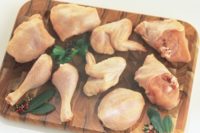Shelflife of Rice Crackers
"The shelf-life of this product is mainly affected by moisture adsorption, as evidenced by sensory evaluation. The Guggenheim-Anderson-de Boer (GAB) model was used to fit the moisture sorption isotherm. Good precision of fit was found as measured by a determination coefficient (R-2) close to 1. The shelflife was then predicted, based on the relationship between permeability coefficient of the packaging materials and moisture adsorbed by the rice crackers determined by the GAB equation.
"The validation of the simulations against the experimental shelflife gave R-2 of 0.90 and 0.51, and root mean square error of 2.93 and 5.20 for RC-1 and RC-2, respectively. The simulation model was found to be applicable for a rapid and accurate shelflife prediction of RC-1. However, a large difference between experimental and simulated shelflife of RC-2 was probably because the moisture content may not be the only parameter influencing the shelflife of the RC-2 samples," wrote U. Sirpatrawan and colleagues, Chulalongkorn University.
The researchers concluded, "Other factors may also significantly affect the shelf-life characteristics of the packaged rice crackers."
Sirpatrawan and colleagues published their study in the Journal of Food Quality ("Shelflife Simulation of Packaged Rice Crackers." Journal of Food Quality, 2009;32(2):224-239).
For additional information, contact U. Sirpatrawan, Chulalongkorn University, Faculty Science, Dept. of Food Technology, Bangkok 10330, Thailand.
From the May 11, 2009, Prepared Foods E-dition
Looking for a reprint of this article?
From high-res PDFs to custom plaques, order your copy today!






